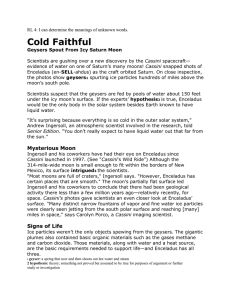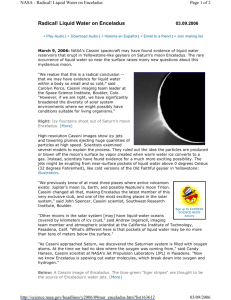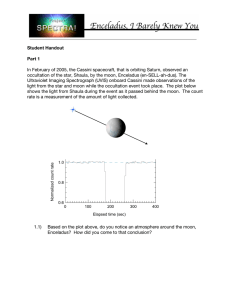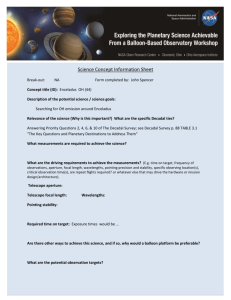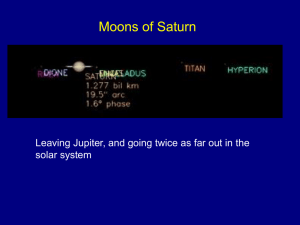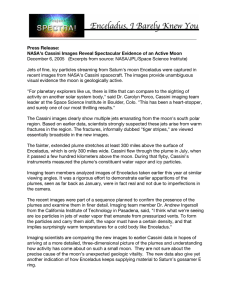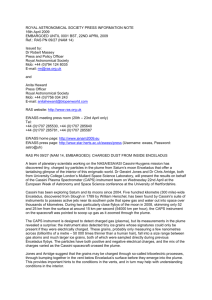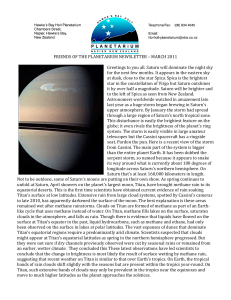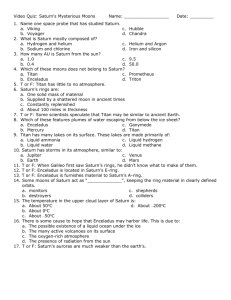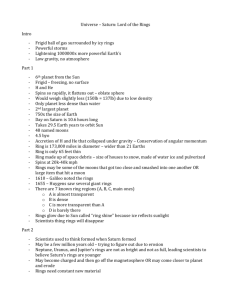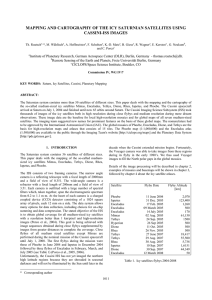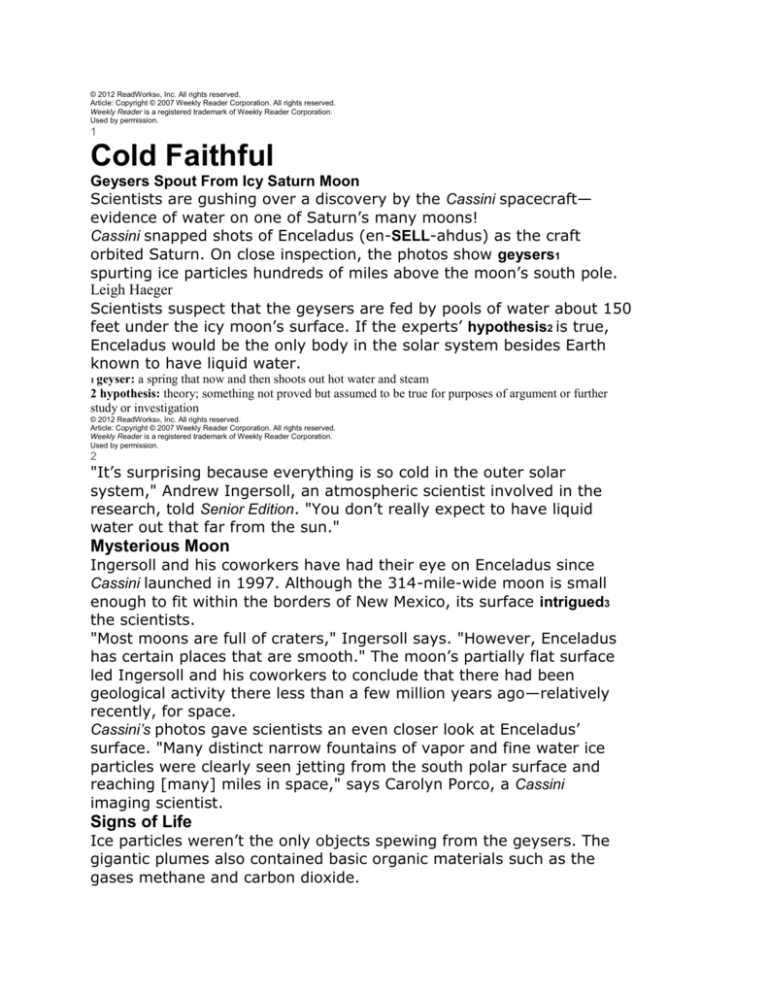
© 2012 ReadWorks®, Inc. All rights reserved.
Article: Copyright © 2007 Weekly Reader Corporation. All rights reserved.
Weekly Reader is a registered trademark of Weekly Reader Corporation.
Used by permission.
1
Cold Faithful
Geysers Spout From Icy Saturn Moon
Scientists are gushing over a discovery by the Cassini spacecraft—
evidence of water on one of Saturn’s many moons!
Cassini snapped shots of Enceladus (en-SELL-ahdus) as the craft
orbited Saturn. On close inspection, the photos show geysers1
spurting ice particles hundreds of miles above the moon’s south pole.
Leigh Haeger
Scientists suspect that the geysers are fed by pools of water about 150
feet under the icy moon’s surface. If the experts’ hypothesis2 is true,
Enceladus would be the only body in the solar system besides Earth
known to have liquid water.
1 geyser:
a spring that now and then shoots out hot water and steam
2 hypothesis: theory; something not proved but assumed to be true for purposes of argument or further
study or investigation
© 2012 ReadWorks®, Inc. All rights reserved.
Article: Copyright © 2007 Weekly Reader Corporation. All rights reserved.
Weekly Reader is a registered trademark of Weekly Reader Corporation.
Used by permission.
2
"It’s surprising because everything is so cold in the outer solar
system," Andrew Ingersoll, an atmospheric scientist involved in the
research, told Senior Edition. "You don’t really expect to have liquid
water out that far from the sun."
Mysterious Moon
Ingersoll and his coworkers have had their eye on Enceladus since
Cassini launched in 1997. Although the 314-mile-wide moon is small
enough to fit within the borders of New Mexico, its surface intrigued3
the scientists.
"Most moons are full of craters," Ingersoll says. "However, Enceladus
has certain places that are smooth." The moon’s partially flat surface
led Ingersoll and his coworkers to conclude that there had been
geological activity there less than a few million years ago—relatively
recently, for space.
Cassini’s photos gave scientists an even closer look at Enceladus’
surface. "Many distinct narrow fountains of vapor and fine water ice
particles were clearly seen jetting from the south polar surface and
reaching [many] miles in space," says Carolyn Porco, a Cassini
imaging scientist.
Signs of Life
Ice particles weren’t the only objects spewing from the geysers. The
gigantic plumes also contained basic organic materials such as the
gases methane and carbon dioxide.
Those materials, along with water and a heat source, are the basic
requirements needed to support life—and Enceladus has all three.
"If we’re right, we think we’re looking at [an] environment in the solar
system [besides Earth] where we have liquid water and the potential
for living organisms," Porco told reporters.
Scientists say that if the moon could support life, the creatures
probably would live under its surface, near the water. The life-forms
3 intrigued: interested; made curious
© 2012 ReadWorks®, Inc. All rights reserved.
Article: Copyright © 2007 Weekly Reader Corporation. All rights reserved.
Weekly Reader is a registered trademark of Weekly Reader Corporation.
Used by permission.
3
most likely wouldn’t have anything in common with Marvin the
Martian. "[They] would be the most simple forms of life imaginable—
bacteria," Ingersoll says.
Future Explorations
More recently, Cassini flew by Enceladus in April 2012.
"There’s no question, along with [Saturn’s] moon Titan, Enceladus
should be a very high priority for us" in future space missions,
Jonathan Lunine, a Cassini scientist at the University of Arizona, told
the Los Angeles Times. "Saturn has given us two exciting worlds to
explore."
Cassini's Wild Ride
Enceladus’ geysers aren’t Cassini’s only claim
to fame. The bus-sized space probe is in the
process of orbiting Saturn 76 times.
Using five telescopes, the probe is taking
300,000 images of the planet, its 47 known
moons, and its rings. Cassini is also collecting
space particles and measuring conditions such
as temperature.
NASA
Cassini nabbed this shot of
Enceladus’ geysers.
Questions: Cold Faithful
© 2012 ReadWorks®, Inc. All rights reserved.
1
Name: _____________ Date: _______________________
1. What was most surprising about the discovery that there might be liquid
water on
Enceladus?
A Enceladus is not a planet
B Enceldaus is very far from the sun
C Enceldaus is 314 miles wide
D Enceldaus is one of Saturn’s 47 moons
2. Read these two sentences from the passage:
“Those materials [gases methane and carbon dioxide], along with water and
a heat
source, are the basic requirements needed to support life—and Enceladus
has all three.”
"If we’re right, we think we’re looking at [an] environment in the solar
system [besides
Earth] where we have liquid water and the potential for living organisms,"
Porco told
reporters.
Which of the following describes the relationship between the two
sentences?
A The sentences agree with one another.
B The first sentence presents one side of an argument and the second
sentence
presents the opposing argument.
C The first sentence presents a problem and the second sentence presents a
solution.
D The first sentence presents information and the second sentence draws a
conclusion.
3. According to the article, all of the following are reasons why scientists
think there
might be life on Enceladus EXCEPT
A geysers have been discovered there
B organic materials such as the gases methane and carbon dioxide were
found on
Enceladus
C Cassini is orbiting Saturn 76 times
D creatures could live under the surface of Enceladus, near the water
Questions: Cold Faithful
© 2012 ReadWorks®, Inc. All rights reserved.
2
4. Read the following sentence and answer the question below: "Many
distinct narrow
fountains of vapor and fine water ice particles were clearly seen jetting from
the south
polar surface and reaching [many] miles in space," says Carolyn Porco, a
Cassini
imaging scientist.
What does the word distinct mean?
A together
B big
C separate
D wavy
5. The primary purpose of this passage is to describe
A what scientists are thinking about Cassini’s discoveries
B what life is like on Enceladus
C the American space program
D describe how geyser’s work on Enceladus
6. According to the passage, why are scientists so excited by the discovery
of geysers
on Enceladus?
_____________________________________________________________
_________
_____________________________________________________________
_________
_____________________________________________________________
_________
7. Does the discovery of geysers on Enceladus answer the question of
whether or not
there is life on that moon of Saturn’s? Why or why not? Give specific
examples from the
text that support your position.
_____________________________________________________________
_________
_____________________________________________________________
_________
_____________________________________________________________
_________
Questions: Cold Faithful
© 2012 ReadWorks®, Inc. All rights reserved.
3
8. The question below is an incomplete sentence. Choose the word that best
completes
the sentence.
There are a number of reasons why scientists think that Enceladus could
support some
form of life, __________ they caution that it would almost certainly be a
very simple
form of life, such as bacteria.
A next
B however
C first
D earlier
9. Answer the following questions based on the sentence below.
The moon’s partially flat surface led Ingersoll and his coworkers to conclude
that there
had been geological activity there less than a few million years ago.
Who? Ingersoll and his coworkers
(did) What?
____________________________________________________________
When?
_____________________________________________________________
___
10. Vocabulary Word: jetting: to gush, spout, or fly out.
Use the vocabulary word in a sentence:
_____________________________________
_____________________________________________________________
_________
_____________________________________________________________
_________
Teacher Guide & Answers: Cold Faithful
© 2012 ReadWorks®, Inc. All rights reserved.
1
Teacher Guide and Answers
Passage Reading Level: Lexile 1170
Featured Text Structure: Cause/Effect – the writer presents the reason an event
happened and its
results
Passage Summary: This passage describes an important, surprising discovery made by
the Cassini
spacecraft – geysers, and the evidence of water on Enceldaus, one of Saturn’s moons – and
considers
whether or not the discovery means that there could be some form of life on Enceldaus.
1. What was most surprising about the discovery that there might be liquid water on
Enceladus?
A Enceladus is not a planet
B Enceldaus is very far from the sun
C Enceldaus is 314 miles wide
D Enceldaus is one of Saturn’s 47 moons
2. Read these two sentences from the passage:
“Those materials [gases methane and carbon dioxide], along with water and a heat source,
are the basic
requirements needed to support life—and Enceladus has all three.”
"If we’re right, we think we’re looking at [an] environment in the solar system [besides
Earth] where we
have liquid water and the potential for living organisms," Porco told reporters.
Which of the following describes the relationship between the two sentences?
A The sentences agree with one another.
B The first sentence presents one side of an argument and the second sentence presents
the
opposing argument.
C The first sentence presents a problem and the second sentence presents a solution.
D The first sentence presents information and the second sentence draws a
conclusion.
3. According to the article, all of the following are reasons why scientists think there might
be life on
Enceladus EXCEPT
A geysers have been discovered there
B organic materials such as the gases methane and carbon dioxide were found on Enceladus
C Cassini is orbiting Saturn 76 times
D creatures could live under the surface of Enceladus, near the water
4. Read the following sentence and answer the question below: "Many distinct narrow
fountains of vapor
and fine water ice particles were clearly seen jetting from the south polar surface and
reaching [many]
miles in space," says Carolyn Porco, a Cassini imaging scientist.
What does the word distinct mean?
A together
B big
C separate
D wavy

